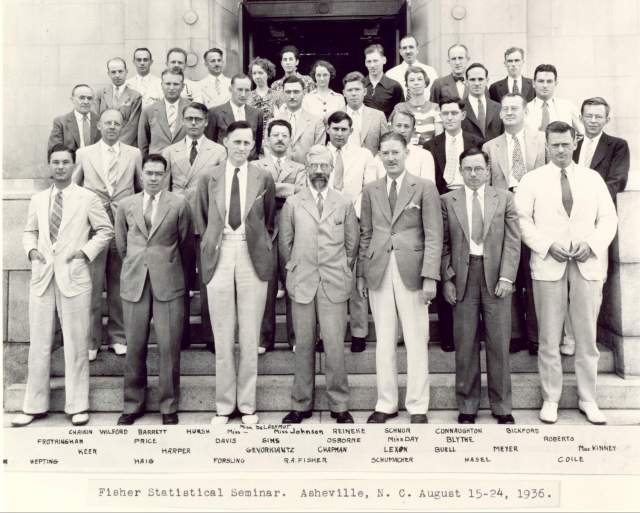Some Giants of Forest Mensuration
by Albert
R. Stage
Rocky Mountain Research Station
 How
does scientific knowledge grow? I think this picture of Sir Ronald. A.
Fisher and some 30 members of Forest Service Research tells a fascinating
story about the propagation of science. Major advances in science are
triggered by new capabilities to “see” objects and processes in action
that had been heretofore unobservable. Along with the invention of
telescopes, microscopes and spectrometers, I include development of
statistical methods for estimating effects not directly evident by
plotting data. Sir R. A. Fisher was a prolific source of such statistical
methods, but disciples also are important to the advance of knowledge. How
does scientific knowledge grow? I think this picture of Sir Ronald. A.
Fisher and some 30 members of Forest Service Research tells a fascinating
story about the propagation of science. Major advances in science are
triggered by new capabilities to “see” objects and processes in action
that had been heretofore unobservable. Along with the invention of
telescopes, microscopes and spectrometers, I include development of
statistical methods for estimating effects not directly evident by
plotting data. Sir R. A. Fisher was a prolific source of such statistical
methods, but disciples also are important to the advance of knowledge.
In 1936, Fisher, Fellow of the Royal Society and Professor at London
University, was a Visiting Professor at Iowa State University. While he
was in the United States, the U.S. Forest Service engaged Fisher to
participate in their yearly series of statistical seminars. His impact on
the group was evident when one reviews the careers and productivity of
those pictured with Fisher during the seminars. Dr. F. X. Schumacher (to
right of Fisher in the photo) was the moderator of the seminars, and
probably was responsible for Fisher’s invitation. Unfortunately, the
contents of Fisher’s lectures were not recorded. However, Dr. Roger
Chapman, whose father attended the seminars, shared with me verbatim notes
of their afternoon discussions.

My review of these notes suggests that “Schu” had a much larger
role as a proponent of Fisher’s methods than would first appear. One of
Fisher’s contributions, a method for inferring relations not directly
observable except in the aggregate, was published by Fisher in his 1924
“The influence of rainfall on the yield of wheat at Rothamsted.”
Within a few years after the Fisher seminars, at least five papers based
on Fisher’s methodology were published by four of the people pictured
with Fisher: Schumacher, Chisman, Day, and Lexen. Schumacher was a
co-author on four of those papers! Later, in 1971, Bob Curtis used newly
available computer power to extend the method to a more sophisticated
conceptualization of the problem of estimating the area utilized by trees
and I used the method to allocate effects of daily moisture stress to
yearly increments of dbh. (Curtis 1971, Zahner and Stage 1966).
Schumacher’s propagation of Fisher’s new methods through leadership
from the Forest Service Washington Office also can be inferred from the
near simultaneous installation of Latin-square thinning trials in the
southeast by Bull, and at Deception Creek Experimental Forest in Idaho by
Kenneth P. Davis. Their study plans, dated in 1933, following publication
in 1925 of Fisher’s book: “Statistical method for research workers”
and two years before his “The design of experiments” attributed the
design to suggestions by V. L. Harper and J. G. Osborne, who also were
participants in the seminar.
Contributions of other attendees come immediately to mind: Bickford,
Hasel, and Osborne were influential in forest inventory. Reineke’s Stand
Density index, Keen’s ponderosa pine vigor classes, Coile’s soil/site
relations, Haig’s yield tables for western white pine, Meyer’s yield
tables for Douglas-fir, Gevorkiantz’ growth predictions for uneven-aged
stands, and Hepting’s contributions to forest pathology were all of
lasting significance. Publications of research are not the only measure of
influence on posterity: fathers of Larry Davis (University of California),
Roger Chapman (Washington State University) and Kent Connaughton (Pacific
Northwest Research Station) are prominent in the picture.
Papers applying Fisher’s method of statistical disaggregation:
Chisman, H.H. and F.X. Schumacher 1940. On the tree-area ratio and
related stand density measures for Douglas-fir. Jour. of Forestry
38(4)311-317.
Curtis, R.O. 1971. A tree area power function and related stand density
measures for Douglas-fir. Forest Science 17(2):146-159.
Fisher, R.A. 1925. The influence of rainfall on the yield of wheat at
Rothamsted. Royal Society London Phil. Trans., Series B. 213:89-142.
Labyak, L.F. and F.X. Schumacher 1954. The contribution of its branches
to the main-stem growth of loblolly pine. Jour. of Forestry 52
(5):333-337.
Lexen, B. 1939. Space requirement of ponderosa pine by tree diameter.
Res. Note 63. U.S.D.A. Forest Service, Southwestern Forest and Range
Experiment Station. 4p.
Schumacher, F.X. and B.B. Day 1939. The influence of precipitation upon
the width of annual rings of certain timber trees. Ecological Monographs
9:387-429.
Schumacher, F.X. and W.C. Jones Jr. 1940. Empirical log rules and the
allocation of sawing time to log size. Jour. of Forestry 38:889-896. |